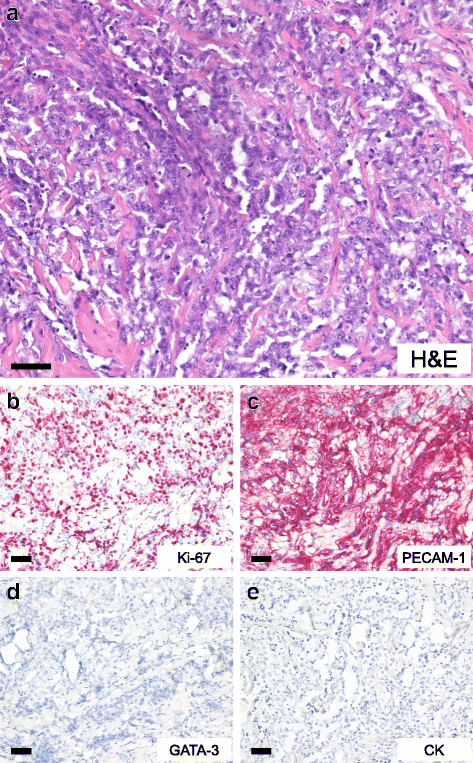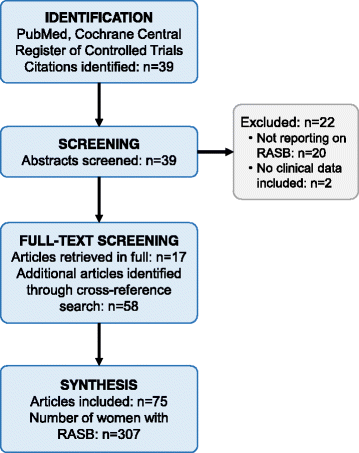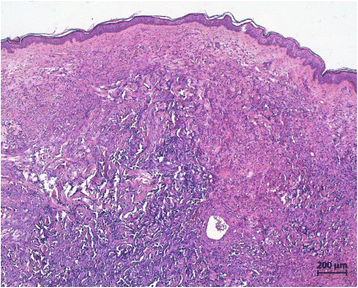Radiogenic angiosarcoma of the breast: case report and systematic review of the literature
- PMID: 29690864
- PMCID: PMC5916720
- DOI: 10.1186/s12885-018-4369-7
Radiogenic angiosarcoma of the breast: case report and systematic review of the literature
Abstract
Background: Radiogenic angiosarcoma of the breast (RASB) is a rare late sequela of local irradiation of the breast or chest wall after breast cancer. The prognosis of women with RASB is poor and there is no standardized therapy for this type of malignancy.
Case presentation: We present the case of a 54 year old woman with RASB (poorly differentiated angiosarcoma of the left breast; pT1, pNX, M0, L0, V0) and a history of invasive-ductal cancer of the left breast (pT1b, G2, pN0, ER positive, PR positive, HER-2/neu negative) treated in July 2012 with breast-conserving surgery, adjuvant chemotherapy with 6 cycles of epirubicin and cyclophosphamide, adjuvant irradiation of the left breast with 50 Gray, and adjuvant endocrine therapy with an aromatase inhibitor. In August 2016, a bilateral salpingo-oophorectomy was performed to remove a tumor of the left ovary, which was diagnosed as breast cancer recurrence. At the same time, a small, purple skin lesion of 1.2 cm in diameter was noted in the inner upper quadrant of the right breast. RASB was diagnosed by punch biopsy and the tumor was excised with clear margins. Imaging studies showed no evidence of further metastases. A systemic chemotherapy with 6 cycles of liposomal doxorubicin was initiated. Five months later, a local recurrence of RASB was diagnosed and mastectomy was performed. Six months later, the patient is alive with no evidence of disease. Three hundred seven cases of RASB were identified. The pooled incidence rate of RASB was 1/3754 women. The most common treatment of RASB was mastectomy in 83% of cases. Adjuvant radiotherapy or chemotherapy were rarely used with 6 and 4%, respectively, whereas in case of recurrence, chemotherapy was the mainstay of treatment, used in 58% of cases. Radiotherapy and repeated surgery were also common with 30 and 33% of cases, respectively. Overall, the prognosis of women with RASB was poor and the recurrence-free survival was short with a mean of 15.9 months. Mean overall survival was 27.4 months.
Conclusion: RASB is a rare late complication of breast irradiation. The prognosis of women with RASB is poor. Surgery is the mainstay of treatment for localized disease while systemic chemotherapy and re-irradiation are appropriate for women with disseminated or recurrent RASB.
Keywords: Cancer syndrome; Endometrial cancer; HNPCC; Ovarian cancer; Synchronous cancer; Young women.
Conflict of interest statement
Ethics approval and consent to participate
The patient provided written informed consent for this treatment. We did not obtain Ethics Committee approval, since no approval is required for a case report and literature review.
Consent for publication
Written informed consent for publication of the clinical details and images was obtained from the patient described in the case report. A copy of the consent form is available for review by the Editor of this journal.
Competing interests
The authors declare that they have no competing interests.
Publisher’s Note
Springer Nature remains neutral with regard to jurisdictional claims in published maps and institutional affiliations.
Figures



References
-
- Laé M, Lebel A, Hamel-Viard F, Asselain B, Trassard M, Sastre X, Kirova YM. Can c-myc amplification reliably discriminate postradiation from primary angiosarcoma of the breast? Cancer Radiother. 2015;19:168–74. - PubMed
-
- Marchal C, Weber B, de Lafontan B, Resbeut M, Mignotte H, Du Chatelard PP, Cutuli B, Reme-Saumon M, Broussier-Leroux A, Chaplain G, Lesaunier F, Dilhuydy JM, Lagrange JL. Nine breast angiosarcomas after conservative treatment for breast carcinoma. A survey from French comprehensive Cancer Centers. Int J Radiat Oncol Biol Phys. 1999;44:113–119. doi: 10.1016/S0360-3016(98)00537-9. - DOI - PubMed
Publication types
MeSH terms
Substances
Supplementary concepts
LinkOut - more resources
Full Text Sources
Other Literature Sources
Medical
Research Materials
Miscellaneous

